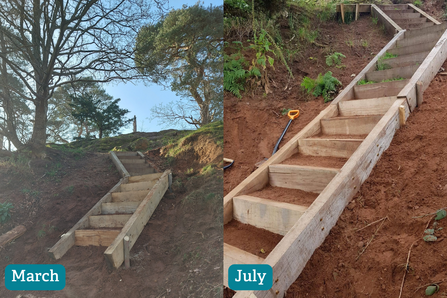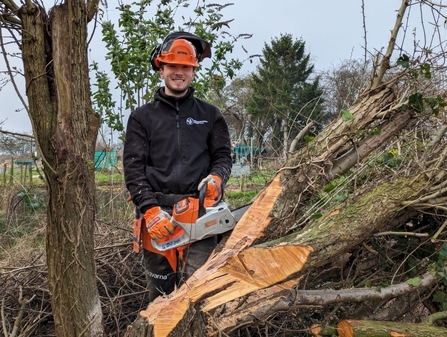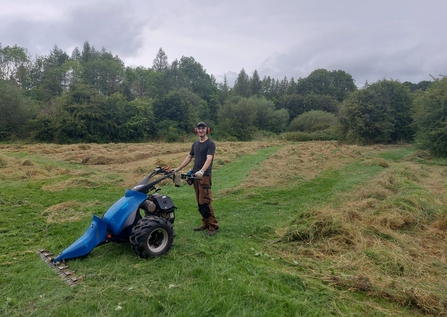And just like that, my time as a conservation trainee has come to an end. It’s been a fantastic experience and a bit of a journey. I’m so happy to have had this opportunity, it has allowed me to build my practical skills and knowledge of wildlife in such an enjoyable way- although that’s not to say it hasn’t been hard work at times! I won’t miss hefting big oak sleepers up the steps at The Devil’s Spittelful nature reserve, although it has been satisfying seeing the improvements we’ve made to them as a team. That’s one of the best things about the traineeship; the sense of fulfilment and satisfaction when you get the job done. Whether it’s replacing a rotten yet stubborn gate post or trying to lay an old and brittle hawthorn hedge, it may be a bit challenging but it’s all worth it.
From countryside to city
Trust Land Rover at Green Farm by Matt Martin

The Devil's Spittleful steps in March and July by Matt Martin
I can say that everything I know about conservation and wildlife I owe to my time at Worcestershire Wildlife Trust. When I started, even as a volunteer before the traineeship, my knowledge and experience was very limited. I could just about recognise an oak tree by its leaf and I had no idea what sort of conservation work got done on nature reserves. Although that was the case, I was made welcome as a volunteer and the learning hasn’t stopped since. Now I can identify tree species like Swedish whitebeam and black poplar, I know how to maintain hedgerows for wildlife and why meadows are cut and grazed. It’s all thanks to how helpful everyone has been, the reserve officers and team leader Andy B, who are always happy to answer questions about reserve management or species identification.

Trainee Matt with a chainsaw
Over the course of the traineeship, I’ve been lucky enough to have worked in roughly 30 different nature reserves. Some reserves I only got see once, such as Badgers Hill and Broadway Gravel Pit. Some I saw plenty of, either Chaddesley Woods or Hornhill Wood would take first place for most often visited. Chaddesley Woods was where we all practised our chainsaw skills and took our felling assessments. I’m glad I won’t have to do any more digging in Hornhill Wood, as we spent several long days improving drainage for the main track.
To get to all the reserves, the trainee team use the Trust’s Land Rover Defender 130. It’s a bit clunky and takes some getting used to – the handbrake is down by your ankles and the gear stick feels miles away! After some time, it became quite enjoyable to drive, especially across fields and down woodland tracks; sometimes it can feel like a bit of a safari.
What will I be doing now? I’m very excited to be joining Worcester City Council to help manage their nature reserves, using all I have learnt to benefit our wildlife in the city. I feel it’s a really good next step for me as it’s hands-on practical conservation, doing what I enjoy most, but also I’ll be planning what needs to be done on the reserves. This kind of urban conservation is new to me. Instead of reserves being surrounded by trees and fields, it will be houses and parks in most cases. I’m excited for a new challenge and I’m sure I’ll learn a lot more about people and nature reserves.
The traineeship has been a blessing for me. Having come out of college not even with a relevant environmental qualification, just a keen interest, it’s thanks to all the staff and volunteers who gave me their time and patience. To have had the opportunity to learn all about conservation and our wildlife whilst working to help it thrive has been a privilege. I’ll make sure to continue working and caring for our wild spaces as much as I can, using all I have learnt from everyone at the Trust.

Matt mowing in the summer

